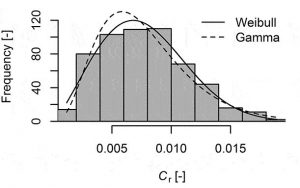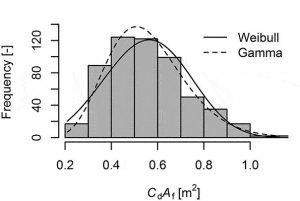Resistance parameters measured for real cyclists intercepted in Vancouver
For the first time, scientists have reliably measured how efficient typical urban bikes actually are. Their study showed that most people’s bikes are much slower than previously thought. There is also more variation between different bikes.
Two things primarily determine how fast a bike is when riding on level ground – the aerodynamic drag and the rolling resistance. Aerodynamic drag is represented by the effective frontal area while rolling resistance is represented by a dimensionless coefficient. Estimates for the values for these resistance parameters have previously focused on sport cyclists. Although some measurements have been made for urban utility bikes, these have been carried out under idealized conditions.
Method
In this study, scientists stopped real cyclists on a bike path in Vancouver and tested their bikes. The rolling resistance and aerodynamic drag were measured using a coast-down test. This involves the cyclist coasting from a cruising speed to a stop, while the speed of the bike is accurately measured. Since rolling resistance causes a constant force, while drag causes a force that depends on the velocity squared, it is possible to estimate both parameters by fitting a curve to the speed measurements.
Coast-down isn’t as accurate as other methods such as wind tunnel tests but it is convenient for cyclists that have been intercepted on their way past. For this study, infrared time traps were used to measure the speed of the cyclists as well as ultrasonic anemometer measurements to correct for wind speed. The test was rigorously evaluated and found to be sufficiently accurate. The uncertainty (standard deviation) of the coefficient of rolling resistance was 0.001 and for the effective frontal area, it was 0.1 m2. The air density was estimated from altitude and temperature using the equation:
where ρ0=1.293 kg/m3, h is altitude above sea level in km and T is absolute temperature (k)
557 cyclists were intercepted and tested at 9 locations in Vancouver. They were aged between 6 and 80 and riding a wide range of bikes. Most cyclists coasted with pedals parallel to the ground which probably reduced drag slightly. If they had pedalled backwards, this would have more accurately represented the typical drag when cycling. Since the bikes were tested as they were found, the rolling resistance may, in some cases, include rolling resistance.
Results
The study showed that resistance parameters are higher than previously thought. This means that real bikes are slower than the ones previously measured.
The study showed that resistance parameters are higher than previously thought. This means that real bikes are slower than the ones previously measured.
The mean coefficient of rolling resistance of was 0.0077 with a standard deviation of 0.0035, after removing variation explained by the measurement uncertainty. The distribution had a skewness of 0.47 and was best approximated by a Weibull distribution. The range of values, after correcting for measurement variation, was from 0.001 to 0.015.

The mean effective frontal area was 0.559 m2 with a standard deviation of 0.14 m2 after correcting for measurement variation. The distribution had a skewness of 0.58 and was best approximated by a Gamma distribution. The range of values, after correcting for measurement variation, was 0.28 to 0.83 m2. Assuming a typical air density of 1.2 kg/m3, these results equate to dimensionless drag factors (KA), of between 0.17 and 0.5.

The mean combined mass of bicycle and cargo was 18.3 kg with a standard deviation of 4.1 kg.
Results showed the expected correlations with wider and more upright rider positions causing more aerodynamic drag, and lower pressure tires with larger treads causing more rolling resistance.
Abstract:
This study investigates the rolling and drag resistance parameters and bicycle and cargo masses of typical urban cyclists. These factors are important for modelling of cyclist speed, power and energy expenditure, with applications including exercise performance, health and safety assessments and transportation network analysis. However, representative values for diverse urban travellers have not been established. Resistance parameters were measured utilizing a field coast-down test for 557 intercepted cyclists in Vancouver, Canada. Masses were also measured, along with other bicycle attributes such as tire pressure and size. The average (standard deviation) of coefficient of rolling resistance, effective frontal area, bicycle plus cargo mass, and bicycle-only mass were 0.0077 (0.0036), 0.559 (0.170) m2, 18.3 (4.1) kg, and 13.7 (3.3) kg, respectively. The range of measured values is wider and higher than suggested in existing literature, which focusses on sport cyclists. Significant correlations are identified between resistance parameters and rider and bicycle attributes, indicating higher resistance parameters for less sport-oriented cyclists. The findings of this study are important for appropriately characterising the full range of urban cyclists, including commuters and casual riders.
Reference:
Title: Physical characteristics and resistance parameters of typical urban cyclists
Authors: Simone Tengattini; Alexander York Bigazzi
ISSN: 0264-0414 , 1466-447X; DOI: 10.1080/02640414.2018.1458587
In: Journal of sports sciences, 2018, Vol.36(20), p.2383-2391
Let us know what you think